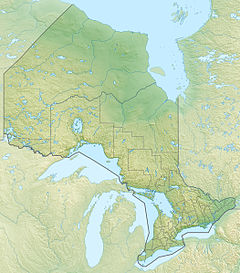
Back نهر نيبغون Arabic نهر نيبجون ARZ Nipigon River CEB Нипигон (юханшыв) CV Nipigon River German Rivière Nipigon French 니피곤강 Korean Nipigon (elv) NB Нипигон (река) Russian Nipigon River Swedish
| Nipigon River | |
|---|---|
 Nipigon River viewed to the south, with Nipigon Bay in the distance | |
| Location | |
| Canada | |
| Province | Ontario |
| District | Thunder Bay |
| Physical characteristics | |
| Source | Lake Nipigon |
| • coordinates | 49°27′35″N 88°13′00″W / 49.45972°N 88.21667°W |
| • elevation | 259 m (850 ft) |
| Mouth | Nipigon Bay |
• location | Red Rock |
• coordinates | 48°57′42″N 88°15′00″W / 48.96167°N 88.25000°W |
• elevation | 184 m (604 ft) |
| Length | 48 km (30 mi)[1] |
| Basin size | 25,400 km2 (9,800 sq mi)[2] |
| Discharge | |
| • location | Alexander Generating Station |
| • average | 350 m3/s (12,000 cu ft/s)[3] |
| Basin features | |
| River system | Great Lakes Basin |
| Waterbodies | Helen Lake |
| Bridges | Nipigon River Bridge, CP Railway Bridge |
The Nipigon River is located in Thunder Bay District in Northwestern Ontario, Canada.[4] The river is about 48 km (30 mi) long[1] (or 209 kilometres (130 mi) when measured to the head of Ombabika River[2]) and 50 to 200 m (160 to 660 ft) wide[citation needed], and flows from Lake Nipigon to Nipigon Bay on Lake Superior at the community of Red Rock, dropping from an elevation of 260 to 183 m (853 to 600 ft). It is the largest tributary of Lake Superior.[5]
Since 1943, 14,360 square kilometres (5,545 sq mi) of the Ogoki River basin has been diverted to the headwaters of the Little Jackfish River, a tributary of Lake Nipigon. This diversion increases the size of the river's watershed by almost 60% to 39,760 square kilometres (15,350 sq mi), and contributes an average of about 116 cubic metres per second (4,100 cu ft/s) to the Nipigon River.[6][7] This increased flow has caused significant erosion and landslides along the river.[5]
- ^ a b "Lake Nipigon - lake, Ontario, Canada". www.britannica.com. Encyclopaedia Britannica. Retrieved 17 October 2022.
- ^ a b "The Atlas of Canada - Rivers". Natural Resources Canada. 2010-10-25. Archived from the original on 2013-01-22.
- ^ "ALEXANDER GS Watershed Conditions" (PDF). Ontario Power Generation. Retrieved 17 October 2022.
- ^ "Nipigon River". Geographical Names Data Base. Natural Resources Canada. Retrieved 2013-04-01.
- ^ a b Canada's Rivers at Risk (PDF) (Report). WWF-Canada. Fall 2009. Retrieved 18 October 2022.
- ^ United States Great Lakes Basin Commission (1974). Great Lakes Basin Framework Study. [report] - Appendix. Public Information Office, Great Lakes Basin Commission. Retrieved 17 October 2022.
- ^ "An Overview of Great Lakes Diversions". International Joint Commission. Retrieved 29 September 2021.
© MMXXIII Rich X Search. We shall prevail. All rights reserved. Rich X Search
